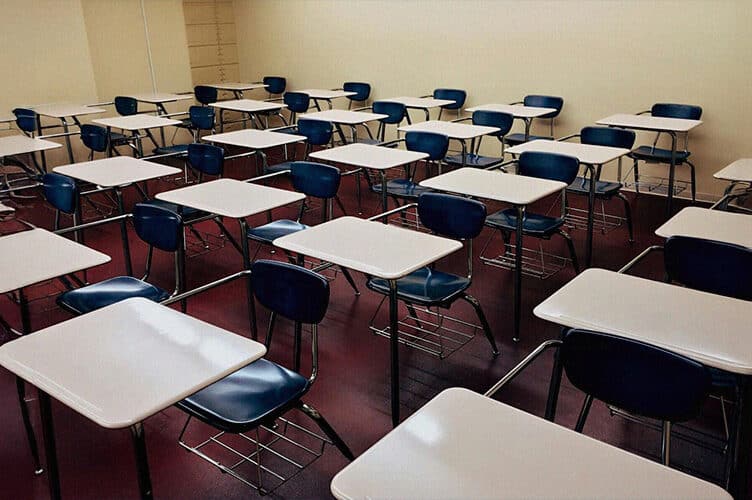CLASSES in several parts of the country were previously suspended due to extreme heat.
This included all in-person classes in elementary and secondary levels in Bacolod City, after state weather bureau Philippine Atmospheric Geophysical and Astronomical Services Administration (PAGASA) forecasted that the heat index would reach as high as 41 and 40 degrees Celsius, on the said dates, respectively.
Such a move was for the safety and welfare of the students, according to Bacolod City Mayor Alfredo Abelardo Benitez. He also encouraged schools to adopt alternative methods of instruction for them on March 11 and 12.
As the country grapples with rising temperatures, should schools opt for a full online learning setup this coming dry season? Several students have varying opinions.
Go for full online learning
One of those who are in favor of shifting to a full online learning setup is Mariallie Mazon from Marinduque State College.
In an interview with republicasia, the 22-year-old college student, whose classes are in a blended learning setup, said such a setup would ease the burden of students and faculty members of having to travel to school amid the extreme heat.
“In this way siguro dapat magbigay paalala sila sa mga students on what to do to prevent heat strokes and dehydration,” Mazon said.
But she also took note of the negative impacts of online learning on students, which she experienced particularly during the COVID-19 pandemic that had everyone stuck at their homes.
“Naka-full online setup kami and it isn’t really that effective in the aspect of grasping the things you have to learn,” she said.
While it gave her time to study on her own and with less distractions, Mazon stressed that she still encountered some difficulties at home such as slow internet connection and frequent power interruptions.
“There was also less interaction with your peers,” she added.
Consider blended learning
But there were students, like Joffrey Ned Basilio from Far Eastern University in Manila, who did not wish to go back to a full online learning setup. What he suggested instead was to consider blended learning, which combines virtual and in-person learning experiences.
While he supports a full face-to-face learning setup like in his university, Basilio believes that schools should opt for online learning “only if the heat may induce illnesses to the students.”
Sharmine Lolong, 23, and Aj Creshia Lopez, 22, were also in favor of blended learning and emphasized that schools should consider the safety and well-being of students and faculty members.
“Students [and] teachers [may] experience or suffer difficulties in concentrating at school due to extreme heat,” Lolong, who is also from Marinduque State College, said.
Lopez, a communication student from Far Eastern University in Manila, noted that not all schools or universities have air-conditioned classrooms that may help students and faculty members cool down from extreme heat.
“We can still learn even [if] we’re at home, and not sacrifice ourselves in commuting just to go [to] our school. Extreme heat is not a joke. We should also take this warning for our health,” she said.
Health risks
High temperatures could be dangerous for the human body. It could have adverse effects on an individual such as dehydration, fainting, heat exhaustion, heat rash, sunburn, and heatstroke, among others.
For Lolong and Mazon, extreme heat could affect their focus on their studies.
“It can feel a little irritating and uncomfortable when you’re sweating in the heat [while] dealing with what you have to study. It lessens your focus,“ Mazon said.
Lolong echoed this and said that schools “should take measures to ensure a comfortable and safe learning environment for all.”
Basilio said that he experiences headaches and nausea due to sudden temperature changes, from commuting and walking along streets in scorching heat to entering a fully air-conditioned classroom in his university.
Like Lopez, she shared that she feels nauseous whenever she travels from her home in Caloocan to her school in Manila. She also mentioned that she had to participate in an outdoor activity for her physical education class.
Schools’ discretion
The Department of Education (DepEd) said that schools may decide on whether or not to suspend classes amid the rising temperatures experienced in the country.
“We have always given flexibility to the school heads to shift to blended learning (modules, online or other alternative delivery modes) in times of disturbances brought about by typhoons, earthquakes and/or extreme heat. This is to ensure that there will be no learning disruption,” DepEd spokesman Michael Poa told republicasia.
This was not the first time that several parts of the country suspended classes due to extreme heat. In 2023, the DepEd issued Memorandum No. 2023-077 dated April 20, 2023, where it specifically cited “extremely high temperatures” as among the valid grounds for suspension or cancellation of face-to-face classes. This, as the agency acknowledged that extreme high temperatures “may considerably affect the conduct of classroom learning and put the learners’ health and wellbeing at risk.”
DepEd Order 037, Series of 2022, titled “Guidelines on the Cancellation or Suspension of Classes and Work in Schools in the Event of Natural Disasters, Power Outages/Power Interruptions, and Other Calamities,” provides for the implementation of modular distance learning (MDL) modes in the event of canceled or suspended classes “to ensure that learning continuity and that learning competencies and objectives are met.”
Meanwhile, PAGASA has yet to announce the beginning of the dry season in the Philippines, but based on its forecast last week, it said that the northeast monsoon (locally known as amihan) may end in the third week of March.
How useful was this post?
Click on a star to rate it!
Average rating 0 / 5. Vote count: 0
No votes so far! Be the first to rate this post.
We are sorry that this post was not useful for you!
Let us improve this post!
Tell us how we can improve this post?









